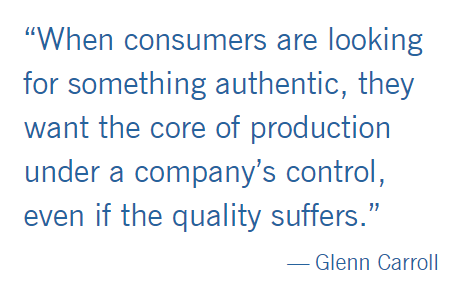Brands of all kinds that want to appear authentic must show consumers a genuine investment in their craft.
Maker’s Mark rotates its oak barrels by hand. Bulleit follows a nearly 200-year-old family recipe. Jack Daniel’s touts its use of handcrafted charcoal and spring water drawn from limestone caverns.
In the world of whiskey, claims of authenticity are ubiquitous. But how do they go down with consumers?
In a new study, Glenn Carroll, a professor of organizational behavior at Stanford Graduate School of Business, looks at whiskey distilleries to gain a broader sense of how consumers perceive authenticity. With Tulane’s J. Cameron Verhaalopen in new window, he finds that intangible features — like the intuition of master distillers, hand-raked grains, or family ties to Prohibition-era moonshiners — matter to consumers, but less so than observable and costly marks of craftsmanship like onsite stills or integrated farming operations.
Their most clear-cut finding is that brands that outsource their distillation appear inauthentic. “We would have been stunned if that hadn’t been the case,” Carroll says. “When consumers are looking for something authentic, they want the core of production under a company’s control, even if the quality suffers.”
That larger takeaway isn’t meant just for whiskey drinkers. Carroll and Verhaal seek to fill a gap in the research into authenticity, which has yet to generate an overall theory of where it originates. “Most of the research on authenticity tends to be specific to a given context,” Carroll says. Researchers tend to burrow into a single subculture or product, like country music, baseball, or handicrafts, and ferret out the defining characteristics of authenticity within that setting. “What would be useful is a more general, abstract understanding of how authenticity works.”
Seeing Is Believing
The whiskey study brings two prominent social science theories to bear on authenticity. Signaling theory suggests that companies or people that make significant and visible investments appear more authentic, as those investments signal a strong commitment to their craft. In whiskey culture, onsite stills are an obvious signal. The theory of essentialism argues that unobservable features, like tradition, family name, or climate, are linked with authenticity. (These two theories are not mutually exclusive.)
Carroll and Verhaal ran four studies to characterize how these different ideas contribute to consumers’ perceptions of authenticity among whiskey distilleries. In the first study, participants — not all whiskey fans — selected which descriptions of a distillery sounded more authentic. The second study analyzed online reviews to determine which features of a particular whiskey corresponded with impressions of authenticity. The final two studies were experiments that used hypothetical descriptions of distilleries to tease out the type of characteristics whiskey drinkers associate with authenticity.
The researchers found evidence to support both signaling theory and the theory of essentialism, though signaling appeared to be more closely linked with perceptions of authenticity. Visible investments that reinforced onsite production were more important to notions of authenticity than more intangible traits like tradition or terroir.
This in itself wasn’t surprising, Carroll says. What was surprising is that signaling appeared to be universally more important than essence in broadcasting a brand’s authenticity. Consumers tended to respond more favorably to features they could see, like the source of the grain or the quality of barrels. “Across the board, there was a very strong emphasis placed on visible features,” he says.
These effects were strongest when a collection of visible features was described together. In terms of appearing authentic, there is some value in a distillery talking about growing its own grain. There is far more value, however, in advertising its holistic ownership of the operation, from growing through processing and production.
“That’s one of the key marketing takeaways,” Carroll says. “If you can cluster together a set of features that demonstrate investment in a craft, then that has a pretty powerful effect conveying authenticity.”
Brewing Trust
Another key takeaway is that companies interested in reaping the rewards of an authentic reputation should not outsource production, even if that means forgoing economic efficiencies.
Carroll and Verhaal point to the craft beer market as an instructional example. The distilled spirits market appears to be where craft brewing was several decades ago. At first, consumers did not know how much of a microbrewery’s beer was made internally. The Boston Beer Company, the early independent brewery behind the Sam Adams brand, was very successful despite outsourcing its production. This changed, though, as the craft movement expanded and matured.
“The communities around these products develop, they gain enthusiasts, review sites appear, and consumers come to know more about your identity as a company,” Verhaal says. “Eventually, you can no longer hide. Consumers will discover that you don’t have a distillery and, more likely than not, that will become a huge problem.”
There are important exceptions to this, however. He notes that Pappy Van Winkle, one of the most sought-after U.S. bourbons, openly outsources its production to the Buffalo Trace Distillery. And yet a bottle of Pappy can go for thousands of dollars. Beyond whiskey, Carroll cites Patagonia, which has a reputation as one of the most authentic clothing brands despite not owning any mills or factories. “This is something to dig into in the future,” Verhaal says.
…
This article first appeared in https://www.gsb.stanford.edu/
Seeking to build and grow your brand using the force of consumer insight, strategic foresight, creative disruption and technology prowess? Talk to us at +971 50 6254340 or engage@groupisd.com or visit www.groupisd.com/story


